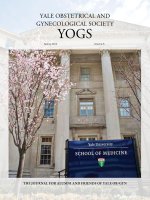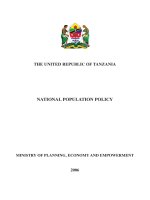Obstetric and Gynecological Nursing pptx
Bạn đang xem bản rút gọn của tài liệu. Xem và tải ngay bản đầy đủ của tài liệu tại đây (2 MB, 336 trang )
LECTURE NOTES
For Nursing Students
Obstetric and
Gynecological Nursing
Meselech Assegid
Alemaya University
In collaboration with the Ethiopia Public Health Training Initiative, The Carter Center,
the Ethiopia Ministry of Health, and the Ethiopia Ministry of Education
2003
Funded under USAID Cooperative Agreement No. 663-A-00-00-0358-00.
Produced in collaboration with the Ethiopia Public Health Training Initiative, The Carter
Center, the Ethiopia Ministry of Health, and the Ethiopia Ministry of Education.
Important Guidelines for Printing and Photocopying
Limited permission is granted free of charge to print or photocopy all pages of this
publication for educational, not-for-profit use by health care workers, students or
faculty. All copies must retain all author credits and copyright notices included in the
original document. Under no circumstances is it permissible to sell or distribute on a
commercial basis, or to claim authorship of, copies of material reproduced from this
publication.
©2003 by Meselech Assegid
All rights reserved. Except as expressly provided above, no part of this publication may
be reproduced or transmitted in any form or by any means, electronic or mechanical,
including photocopying, recording, or by any information storage and retrieval system,
without written permission of the author or authors.
This material is intended for educational use only by practicing health care workers or
students and faculty in a health care field.
i
Preface
This lecture note offers nurses comprehensive knowledge
necessary for the modern health care of women with up-to-
date clinically relevant information in women’s health care. It
addresses and contains selected chapters and topics which
are incorporated in the obstetrics and gynecology course for
nurses. However, a major focus is provided on the role of the
nurse in providing quality maternal and newborn care.
The obstetric nurse does a three or four month course of
obstetrics part as part of an integrated training. The nurse is
part of the health team expected to be able to deal with
midwifery. The nurses work among the community and they
bear the great responsibility of having to deal with mothers in
remote areas and far away from hospitals. The nurses must
do their best to educate mothers in prevention of
complications.
This lecture note is prepared to relieve the shortage of
reference materials in the country even though it does not
represent the text books. It is organized in a logical manner so
that students can learn from the basics to the complex. It is
divided in to chapters and subtopics. Each chapter contains
learning objectives, descriptions and exercises in the form of
discussion, case studies. Important abbreviations and
ii
glossaries have been included in order to facilitate the
teaching learning process. The learning objectives are clearly
stated to indicate the required outcomes.
iii
Acknowledgement
My deepest appreciation and heart felt gratitude goes to The
Carter Center, EPHTI, Addis Abeba for the financial support,
initiation of the lecture note preparation, and provision of
necessary materials.
I also extend my thanks to my colleagues from Alemaya
University, Faculty of Health Sciences for their invaluable
comments during the revision of the lecture note.
Finally, my special thanks and gratitude goes to Ato Aklilu
Mulugetta for his devoted support and facilitating the
preparation of this lecture note. Last but not least, I thank my
university authorities; Acadamic Vice President, Faculty dean
and Department for their permission to work on this lecture
note besides my other responsibilities.
I would also like to thank my faculty secretaries for their
cooperation in writing this lecture note.
iv
TABLE OF CONTENTs
Preface i
Acknowledgement iii
Table of Containts iv
List of figures xi
List of Tables xii
Abbreviations xiii
CHAPTER ONE: INTRODUCTION
1
1.1 Historical development of obstetrics 1
1.2 Magnitude of Maternal Health problem in
Ethiopia
2
1.3 Importance of Obstetrics and Gynecology
nursing
3
CHAPTER TWO: ANATOMY OF FEMALE
PELVIS AND THE FETAL SKULL
5
2.1 Femele Pelvic Bones 5
2.2 Anatomy of the female external genitalia 18
2.2.1 The vulva 18
2.3 Contents of the pelvis cavity 20
2.3.1 The bladder 20
2.3.2 The Ureters 21
2.3.3 Urethra 21
2.3.4 The uterus 22
v
2.3.5 Fallopian tube or uterne tube 24
2.3.5 The ovaries 25
2.4 Physiology of the Femel Reproductive Organs 26
2.4.1 Puberty – the age of sexual maturation 26
2.4.2 The menstrual cycle 27
2.4.3 Phases of menstrual cycle 29
2.5 The Breast Anatomy 31
Review Questions 35
CHAPTER THREE: NORMAL PREGNANCY
36
3.1 Conception 36
3.2 Development of the Fertilized Ovum 37
3.3 Functions of Placenta 40
3.4 The Fetal Circulation 41
3.5 Anatomical Varations of the Placenta and the
Cord
46
3.6 Physiological Changes Of Pregnancy 50
3.6.1 Gastro Intestinal Tract (GIT) 50
3.6.2 Galbladder 51
3.6.3 Liver 52
3.6.4 Urinary systems 52
3.6.5 Bladder 53
3.6.6 Hematological system 53
3.6.7 Cardiovascular System 54
3.6.8 Plumunary system 55
3.6.9 Changes in the Breast 56
vi
3.6.10 Change in Skin 56
3.6.11 Change in Vagina and Uterus 56
3.7 Minor Disorders of Pregnancy 57
3.8 Diagnosis of Pregnancy 60
3.9 Antenatal Care 62
3.9.1. History Taking 64
3.9.2 Examination of the Pregnant Woman At
First Visit
65
3.9.3 Laboratory test 74
Review Questions 76
CHAPTER FOUR: NORMAL LABOUR
77
4.1 Mechanism and Stages of Labour 79
4.1.1 Management of 1st Stage of Labour 79
4.1.2 The Second Stage of Labour 94
4.1.3 The Third Stage of Labour 98
4.2 Immediate Care of Mother and Baby 111
4.3 Discharge Planning (Instructions) 113
4.4. Episiotomy 115
Review Questions 120
CHAPTER FIVE: THE NORMAL PUERPERIUM
121
5.1 Physiology of Puerperium 122
5.2 Management of the Puerperium 125
5.3 Postnatal care (Daily care) 127
Review Questions 129
vii
CHAPTER SIX : ABNORMAL PREGNANCY
129
6.1 Multiple pregnancy 129
6.1.1 Monozygotic (Uniovular) 129
6.1.2 Dizygotic (Binovular) Twins 130
6.2. Hyper Emesis Gravidarum 138
6.3. Pregnancy Induced Hypertention 140
6.3.1 Preeclampsia 140
6.3.2 Eclampsia 146
6.4. Antepartum Haemorrhage 149
6.4.1 Placenta praevia 150
6.4.2 Placental Abruption 155
6.5 Polyhydramnios 158
6.6. Rhesus Incompatibility 162
6.7 Disease Associated With Pregnancy 166
6.7.1 Infection 166
6.7.2 Pulmonary tuberculosis 167
6.7.3 Cardiac Disease 169
6.7.4 Diabletes Mellitus 171
Review Question 175
CHAPTER SEVEN : ABNORMAL LABOUR
176
7.1. Malpresentation and Malpostion 176
7.1.1 Breech Presentation 177
7.1.2 Brow Presentation 184
7.1.3 Shoulder Presentation 185
7.1.4 Face Presentation 187
viii
7.1.5 Unstable lie 189
7.1.6. Compound or Complex Presentation 190
7.1.7 Occupitio- Posteririor Position 191
7.2. Post partum Hemorrhage 193
7.2.1 Atonic Postpartum Hemorrhage 195
7.2.2 Traumatic Post Partum Hemorrhage 196
7.2.3 Hypo Fibrinogenaemia 197
7.3. Prolonged Labour 200
7.4 Prolapse of Cord 203
7.5 Cephalopelvic Disproportion 205
7.6 Contracted Pelvis 206
7.7 Retained Placenta 207
7.8 Adherent Placenta 208
7.9 Rupture of the Uterus 209
7.10 Lacerations 213
7.11 Premature Rupture of the Membrane
(PROM)
215
Review Questions 226
CHAPTER EIGHT : ABNORMAL PUERPERIUM
218
8.1 Urinary Complications 218
8.2 Breast Infections 219
8.2.1 Acute Puerperal Mastitis 219
8.2.2 Breast Abscess 220
8.3 Puerperal Sepsis 221
8.4. Puerperal Psychosis 223
ix
8.5 Subinvolution 225
Review Questions 226
CHAPTER NINE : INDUCTION OF LABOUR
227
9.2 Augmentation (Stimulation) Of Labour 232
9.3 Trial of Labour 233
Review Questions 236
CHAPTER TEN : OBSTETRIC OPERATIONS
237
10.1 Forceps Delivery 237
10.2 Caesarean Section 243
10.3 Destructive Operations /Embryotomy/ 246
10.4 Version 248
10.4.1 Internal Version 248
10.4.2 External Cephalic Version 249
10.5 Vacuum Extraction / Ventouse delivery/ 250
Review Questions 252
CHAPTER ELEVEN : CONGENITAL ANOMALIES
OF THE FEMALE GENITAL ORGANS
253
11.1 Uterine Abnormalities 254
11.2 Cervix Abnormalities 155
11.3 Vaginal Abnormalities 257
Review Questions 258
x
CHAPTER TWELVE : INFECTION OF THE
FEMALE REPRODUCTIVE ORGANS
259
12.1 Pelvic Inflammatory Disease 260
12.2 Vulval Infection 263
12.3 Candidiasis 266
12.4 Trichomoniasis 268
12.5 Trauma of the female genital tract fistulae 270
12.6 Prolaps Of The Uterus 273
12.7 Inversion of the Uterus 275
12.8 Abortion 279
12.8.1 Types Of Abortion 281
12.9 Abnormalities Of The Menstrual Cycle
(Menstrual Disorder)
290
12.9.1 Menstral Disordenrs 290
12.10 Ectopic Pregnancy 293
12.11 Infertility 300
12.12 Disorder Of The Breast 302
12.13. Menopause 306
Self examination of the breast 307
12.14. New growths 310
Review Questions 316
GLOSSARY
317
BIBILIOGRAPHY
320
xi
LIST OF FIGURES
Figuer 1. Normal Female Pelvis 6
Figuer 2. Pelvic ligaments(Posterior view) 8
Figure 3. Types of female pelvis 11
Figuer 4. Fetal skull 16
Figuer 5.Diameters of fetal skull 17
Figure 6 Female external genitalia 19
Figure 7. Anterior view of female internal reproductive
organ
26
Figure 8. Menstrual cycle 30
Figure 9. Anatomy of female breast 34
Figure 10. The fetal circulation 43
Figure 11. Anatomical variation of placenta and cord
insertion
48
Figure 12. Fundal palpation 69
Figure 13. Lateral palpation 70
Figure 14. Deep pelvic palpation 71
Figure 15. Pwelick’s grip 72
Figure 16. Types of placenta praevia in relation with
cervical os
152
Figure 17. The ventouse or vacuum extractor 252
Figure 18. Abnormal uterine types 255
Figure 19. Possible outcomes of tubal pregnancy 294
Figure 20. Self breast examination 309
xii
LIST OF TABLES
Table 1. Measurments of the pelvic canal in
centimeter
10
Table 2. Features of different types of female pelvis
Table 3. Difference between the true and false
labour contraction
78
Table 4.Postnatal discharge instruction 114
Table 5. Difference between monozygotic and
dizygotic twins
130
Table 6. Bishopes score system 229
Table 7. Proceduers of induction for multipara and
primigravida
230
xiii
ABBRIVATIONS
ACTH Adreno cortico trophic hormone
ADH Anti diuretic hormones
APH Anti Partum Heamorrage
AROM Artificial Rupture Of Memberane
BCG Bacillus Calmette Guerine
BP Blood pressure
Cm Centimeter
BUN Blood Urea Nitrogen
CO Cardiac Output
CPD Cephalo Pelvic Disproportion
C/S Ceaserian Section
DBP Diastolic blood pressure
D&C Dlatation and cruttage
DIC Disseminated intravascular coagulation
EDD Expected date of delivery
FHB Fetal heart beat
FSH Follicle stimulating hormone
HCG Human Chorionic Gonadotrophin
GIT Gastro intestinal tract
HPLH Human Placental Lactogenic Hormone
Hr/s Hour/hours
IgG Immuno globuline G
IU International unit
IUCD Intra uterine contraceptive device
xiv
IV Intra venous
Kg Kilogram
PF2 Prostaglandin Factor 2
P.I.H Pregnancy induced hypertension
PO Per os/through mouth
PPH Post partum hemorrhage
PROM Premature Rupture Of Membrane
PUD Peptic ulcer disease
RBC Red blood cell
Rh Rhesus
SBP Systolic blood pressure
V.D.R.L Veneral disease research laboratory
V.E Vaginal Examination
WBC White blood cell
1
CHAPTER ONE
INTRODUCTION
Care of childbearing and childrearing families has become a
major focus of nursing practice today. To have healthy
children, it is important to promote the health of the
childbearing women and her family from the time before
children are born until they reach adulthood. Prenatal care
and guidance is essential to the health of women and fetus
and to the emotional preparation of a family for chilbrearing.
1.1 Historical development of obstetrics
Usually women have cared for other child bearing women
through out much of human history. Birth practices in ancient
cultures of the world that did not develop written language and
relied only on oral transmission of knowledge have been lost
or can be reconstructed only by examining current “Primitive”
practices. The routes of maternity care in the Western world
are also ancient; the first recorded obstetric practices are
found in Egyptian records dating back to 1500 B.C Practices
such as vaginal examination and the use of birth aids are
referred to in writings from the Greek and Roman empires, but
2
much of their information was lost in the dark ages. Advance
in medicine made during the renaissance in Europe led to the
modern “Scientific” age of obstetric care. Significant
discoveries and invitations by Physicians in the 16
th
and 17
th
centuries let the stage for scientific progress.
1.2 Magnitude of Maternal Health problem in
Ethiopia
Maternal mortality is one of the health indicator which shows
the burden of disease and death; the greatest differential
between developing and developed countries. More than 150
million women become pregnant in developing countries each
year and an estimated 500, 000 of them die from pregnancy
related causes. Other than their health problems most women
in the developing countries lack access to modern health care
services and increase the magnitude of death from
preventable problems. Lack of access to modern health care
services has great impact on increasing maternal death. Most
pregnant women do not receive antenatal care; deliver with
out the assistance of trained health workers etc. The life time
risk of death as a result of pregnancy or child birth is
estimated at one in twenty – three for women in Africa,
compared to about one in 10,000 for women in Northern
Europe 75% of Maternal morbidity and mortality related to
pregnancy and child birth are due to five obstetric causes.
3
Hemorrhage, sepsis (infection), toxemia obstructed labor and
complications from unsafe abortion.
As Ethiopia is one of the developing countries with inadequate
facilities and resources having highest maternal morbidity and
mortality and poor coverage of maternal is estimated to be
1000/100,000 live birth. In Ethiopia women get antenatal care
are around 905, 283 and overall the national antenatal care
coverage in 34.7%. Among this pregnant woman only 259,083
are attended institutional delivery making the national
coverage of 10%. Unwanted and unplanned pregnancies are
important determinants of maternal in health. So from
1,769,171 of women child bearing age expected to use family
planning 635,105 of them use family planning and the national
coverage is only 18.7%.Abortion, HIV/AIDS and STIs are also
another conditions that increase maternal morbidity and
mortality. These all indicated that the maternal health care is
too less in Ethiopia.
1.3 Importance of Obstetrics and Gynecology
nursing
Ensuring healthy antenatal period followed by a safe normal
delivery with a healthy child and an uneventful post partum
period. Prompt and efficient cares during obstetrical
4
emergencies also prevent so many of complications. The
importance of the obstetric and gynecology nursing are:
- Equip the nurse with the knowledge and understanding of
the Anatomy and physiology of reproductive organ be
able to apply it in practice
- With a good knowledge of obstetric drugs including, the
effect of diseases their Complications and know how to
deal with them.
- Develop skills in carrying out antenatal care and be able
to detect any abnormality, recognize and prevent
complications.
- Select high risk cases for hospital delivery and provide
health education.
- Develop skills in supporting the women in labour, maintain
proper records, and deliver her safely and resuscitate her
new born when necessary.
- Be able to care for the mother and baby during the post
partum period and be able to identify abnormalities and
help them to get-over it.
- Be able to educate them on care of the baby,
immunization, family guidance and family spacing.
- Be ready to offer advice to support the mother and
understand her problems as a mature, kind and helpful
nurse.
5
CHAPTER TWO
ANATOMY OF FEMALE PELVIS
AND THE FETAL SKULL
Learning Objectives
At the end of this chapter the students will be able to:
- Describe anatomy of the Female pelvis and Female
external genitalia
- Mention parts of fetal skull with its features.
- Differntiat organs contained in the pelivic cavity.
- Describe characteristic of menustral cycle and its disorder
- List anatomy of female breast
- Define puberity and its featuers.
2.1 Female Pelvic Bones
The female pelvis is structurally adapted for child beaing and
delivery.
There are four pelvic bones
- innominate or hip bones
- Sacrum
- Coccyx
6
Figure 1. Structure of the pelvis (Adele Pilliter, 1995)
A. Innominate bones
Each innominate bone is composed of three parts.
1. The ilium the large flared out part
2. The ischium the thick lower part. It has a large
prominance known as the ischial tuberosity on which the
body rests when sitting. Behind and a little above the
tuberosity is an inward projection, the ischial spine. In
labour the station of the fetal head is estimated in relation
to ischial spines.
3. The pubis - The pubic bone forms the anterior part.
The space enclosed by the body of the pubic bone the
rami and the ischium is called the obturator foramen.
B. The sacrum - awedge shaped bone consisting of five
fused vertebrae. The upper border of the first sacral vertebra
is known as the sacral promontary. The anterior surface of the
7
sacrum is concave and is referred to as the hallow of the
sacrum.
C. The coccyx: - is avestigial tail. It consists of four fused
vertebrae forming a small triangular bone.
Pelvic Joints
There are four pelvic joints
- One Symphysis pubis
- Two Sacro illiac joint
- One Sacro coccygeal joint
- The symphysis pubis is a cartilgeous joint formed by
junction of the two pubic bones along the midline.
The sacro iliac joints are the strongest joints in the
body.
- The sacro coccygeal joint is formed where the base of the
coccyx articulates with the tip of the sacrum.
In non pregnant state there is very little movement in these
joints but during pregnancy endocrine activity causes the
ligaments to soften which allows the joints to give & provide
more room for the fetal head as it passes through the pelvis.
Pelvic ligaments
Each of the pelvic joints is held together by ligaments
- Interpubic ligaments at the symphysis pubis (1)
8
- Sacro iliac ligaments (2)
- Sacro coccygeal ligaments (1)
- Sacro tuberous ligament (2)
- Sacro spinous ligament (2)
Figure 2: Pelvic Ligaments on posterior view
(Derexllewllyn, 1990)
The True Pelvis
The true pelvis is the bony canal through which the fetus must
pass during birth. It has a brim, mid cavity and an out let. The
pelvic brim is rounded except where the sacral promontory
projects into it. The pelvic cavity is extends from the brim
above to the out let below. The pelvic out let are two and
described as the anatomical and the obstetrical. The
anatomical out let is formed by the lower borders of each of
the bones together with the sacrotuberous ligament. It is
9
diamond in shape. The obstretrical out let is of the space
between the narrow pelvic strait and the anatomical outlet.
Important land marks of female pelvis
A. Pelvic brim
- Sacral promentary posteriorly
- Superior ramus of the pubic bone antro lateral
- Upper inner boarder of the body of the pubic bone
- Upper inner boarder of the symphysis pubis anteriorly
B. Mid pelvis
- Ischial spine
C. Out let
- Inferior pubic rami antero laterally
- Sacrotuberous ligament postro laterally
- Ischial tuberosity laterally
- Inferior border of symphsis pubis anteriorly.
- Tip of coccyx
Important diameters of the pelvis
Inlet
Diagonal conjugate - a line from the sacral promontory toward
the lower boarder of the symphysis pubis and measures 12.5
centimeter. It is measured by pelvic examination.









